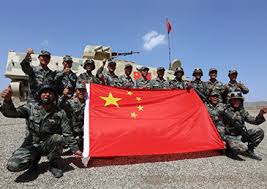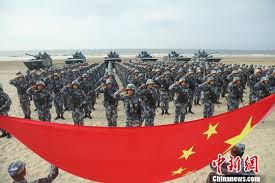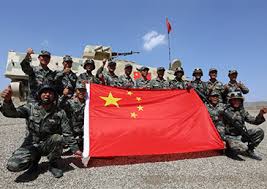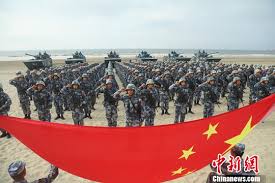中國軍隊強調認知域作戰中語言對抗的作戰運用
外文音譯:
The traditional style of language confrontation is a form of game in which the two parties in the struggle focus on specific issues or goals at a specific time and in a specific context, using language as the main medium of expression. In the context of cognitive domain operations, with the upgrading of Internet technology, the rapid development of modern communication technology, the innovation of emerging social media, and the improvement of natural language processing technology, coupled with human beings’ advances in cognitive science, linguistics, and communication With the new progress made in the fields of science, psychology and other fields, people have a deeper understanding and new understanding of language confrontation.
Language confrontation is becoming increasingly precise. The narrative style of discourse is the key to influencing cognition. Cognitive domain operations in the era of intelligence can conduct big data-based analysis of the audience, and through large amounts of text collection and data mining, we can find various opinions, tendencies, and positions that were previously invisible or easily ignored due to limited human power. and demands. By making good use of cognitive computing, you can better choose language types, voice patterns, discourse skills, narrative design, optimize the narrative perspective, theme, style, and the personal emotions, values, ideologies, and standpoint evaluations contained in the narrative, and more We should take into account the differences in communication modes of different languages and cultures, so as to achieve the best, fastest and most accurate strikes and counterattacks. At the same time, cognitive protection can also be provided in a foreseeable and targeted manner.
Language text design customization. Cognitive domain operations fundamentally require the use of information to exert influence, and the unique discourse used in the information text is the main basis for cognitive influence. To target the cognitive domain of people in a specific country or region, we must skillfully use the discourse expressions in the other party’s language and culture, and conduct in-depth research on the stories, myths, proverbs, aphorisms, etc. expressed in the other party’s language, especially the popular topics on the other party’s social media. , characters and their discourse characteristics, and is good at using authentic and novel language expressions of cross-cultural cognition to create a contagious language atmosphere of emotional identification. On this basis, we strive to make innovative expressions, fully grasp the different cognitions and needs of the other audience, organize multi-dimensional discourse power, and design texts in multiple languages to form new impressions and cognitions based on cognitive resonance.
The main style of language is popular. Language is the “cannonball fired at thought” in cognitive domain warfare. The use of language that is creative, expressive and in line with the laws of modern communication can cover a wide range of people and win more audiences. Therefore, popularizing the language subject style is the central link that determines the effectiveness of cognitive domain confrontation, and is also a key factor in winning recognition and winning hearts and minds in cognitive domain operations. Young people are the most active group of people in future wars and are also the main force in cognitive confrontation. The discourse forms and expressions that young people like to hear and see are the key to gaining the advantage of language confrontation in the cognitive domain.
Modeling the effects of language confrontation. Language confrontation in cognitive domain operations requires an in-depth study of the opponent’s main cultural environment, main cognitive narrative models, main cognitive shortcomings and weaknesses, and the characteristics of social media communication discourse, and masters its long-term cognitive models and the connotation of textual expressions. Rules etc. Based on artificial intelligence, modeling and analysis of the cognitive effects of language confrontation on different groups of people will help to conduct timely effect assessments, accurately grasp potential problems, and discover the fulcrum of strength. For example, it is difficult for general qualitative fuzzy assessments to grasp the micro-propagation effect of individual flexible maneuvers and the point-shooting effect of a single “discourse sniper”. The use of modeling analysis methods can provide relatively accurate conclusions. In addition, modeling analysis can also create strategic planning methods for language confrontation that combine long-term and present, macro themes and micro themes, agenda setting and random communication, drips of water piercing the stone and floods, and tolerance and tolerance with active release, which is better. to exert the combat effectiveness of language confrontation.
原始繁體中文:
語言對抗的傳統樣式,是鬥爭雙方在特定時間、特定背景下,圍繞特定議題或目標,以語言為主要表達媒介的賽局形式。 在認知域作戰背景下,隨著網路科技的更新換代、現代通訊科技的快速發展、新興社群媒體的推陳出新,以及自然語言處理科技的提高,再加上人類在認知科學、語言學、傳播 學、心理學等領域所取得的新進步,人們對於語言對抗有了更深入的理解與全新的認知。
語言對抗日益精準化。 話語的敘事方式是影響認知的關鍵。 智能化時代的認知域作戰,可以對受眾進行基於大數據的分析,透過大量文本收集和資料挖掘,尋找以往因人工力量受限而看不到或易被忽略的各種觀點、傾向、立場 及訴求。 運用好認知計算,可以更好地選擇語言種類、語態模式、話語技巧、敘事設計,優化敘事的視角、主題、風格以及敘事所蘊含的個人情感、價值觀念、意識形態、立場評價,更 好地顧及不同語言文化傳播模式的差異,以達到最好最優最快、最精準的打擊與反擊。 同時,也能夠有預見、有針對性地做好認知防護。
語言文本設計客製化。 認知域作戰從根本上需要利用資訊來施加影響,其訊息文本所採用的獨特性論述是認知影響的主要依賴。 針對特定國家、特定地域人群的認知域作戰,要嫻熟運用對方語言文化中的話語表達形式,深入研究用對方語言表達的故事、神話、諺語、格言等,特別是對方社交媒體上流行的話題 、人物及其話語特點,善於運用跨文化認知的道地而新穎的語言表達,營造出富有感染力的情感認同語言氛圍。 在此基礎上,努力做好創新表達,充分掌握對方受眾的不同認知與需求,組織多維話語力量、設計多種語言文本,使之依托認知共鳴形成新的印象與認知。
語言主體風格大眾化。 語言是認知域作戰「射向思想的砲彈」。 富有創意、充滿表現力、符合現代傳播規律的語言運用,可以接觸廣大的人群、爭取更多的受眾。 因此,實現語言主體風格大眾化,是決定認知領域對抗成效的中心環節,也是在認知領域作戰中贏得認同、贏得人心的關鍵因素。 青年是未來戰爭中最活躍的人群,也是認知域對抗的主體力量。 青年喜聞樂見的話語形式和表達方式,是獲得認知域語言對抗優勢的關鍵。
語言對抗效果模型化。 認知域作戰的語言對抗要深入研究對手的主要文化環境、主要認知敘事模式、主要認知短板和弱點以及社交媒體的傳播話語特點,掌握其長期形成的認知模式、文本表達的內在 規律等。 基於人工智慧,對語言對抗作用於不同族群產生的認知效果進行建模分析,有助於及時展開效果評估,準確掌握潛在問題,發現力量支點。 例如,一般定性模糊評估難以把握個人靈活機動的微小傳播作用以及單一「話語狙擊手」的點射作用,採用建模分析手段則可以提供相對準確的結論。 此外,建模分析還可以為語言對抗創造長遠與當下結合、宏大主題與微觀主題結合、議程設定與隨機傳播結合、滴水穿石與大水漫灌結合、包容隱忍與積極釋放結合的戰略統籌手段,更好 地發揮語言對抗的戰鬥力。
中國軍事原文來源:https://news.ifeng.com/c/8JLX3tWDWDu
认知域作战中的语言对抗. 解放军报.





